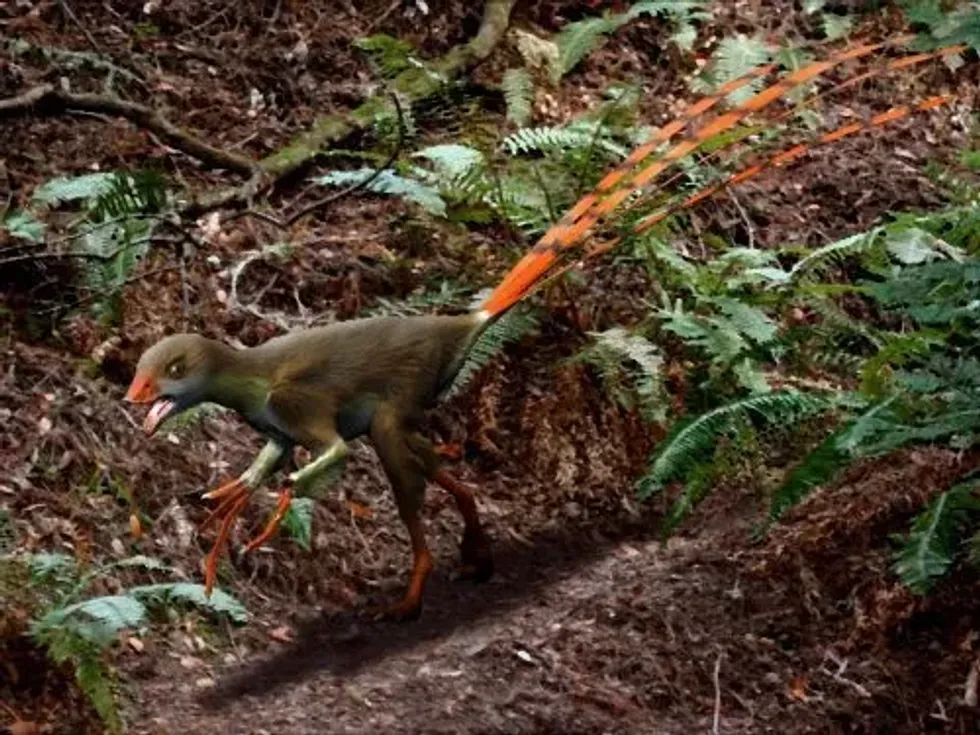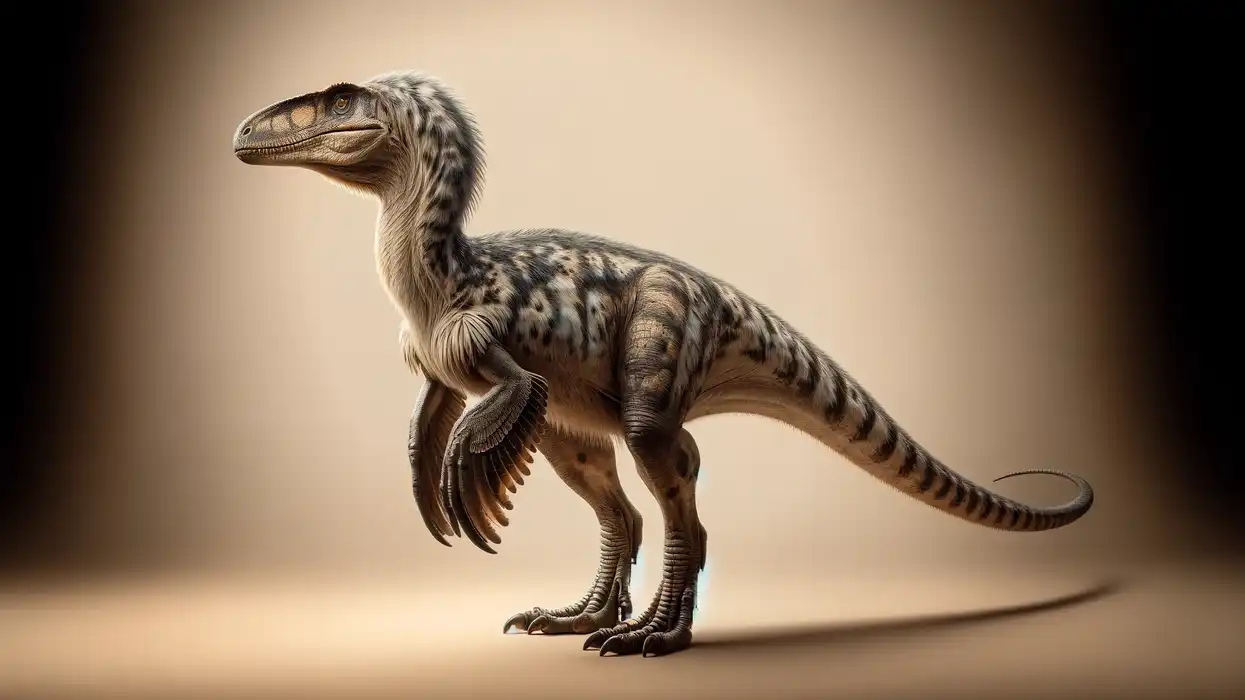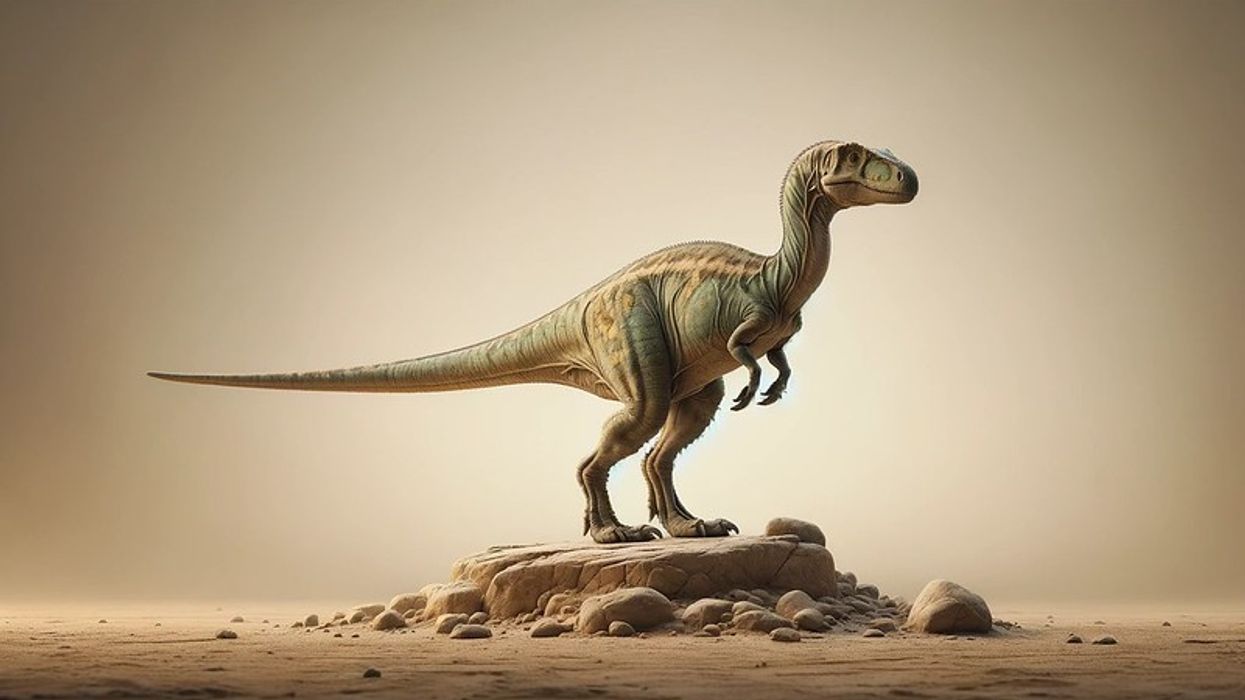Epidexipteryx hui, or E. hui (Epidexipteryx abbreviation), was named by Zhang. It lived in the Late Jurassic period 168 million years ago. Its fossils were found in China in the Daohugou Beds.
Only one well preserved partial skeletal fossil has been found. The dinosaur was a small paravian dinosaur belonging to Scansoriopterygidae. They are feathered dinosaurs who are considered ancestors of modern birds. It had ornamental tail feathers for display and insulation.
It did not have the ability to fly but instead glided. The dinosaur had outward teeth at the front of the jaw and fed on insects, larvae, and invertebrates. It was oviparous and reproduced by laying eggs.
If you like reading facts about Epidexipteryx, also check out interesting facts about sauropelta and Chungkingosaurus.
Epidexipteryx Interesting Facts
How do you pronounce 'Epidexipteryx'?
Epidexipteryx pronunciation is 'ep-ee-decks-ip-ter-ricks'. It was named by Zhang et al. 2008
What type of dinosaur was an Epidexipteryx?
Epidexipteryx is a small primitive paravian dinosaur that belongs to the Scansoriopterygidae family. It is a family of climbing and gliding dinosaurs.
In which geological period did the Epidexipteryx roam the Earth?
The Epidexipteryx lived during the Middle Jurassic and Late Jurassic period 160-168 million years ago. The Late Jurassic period is also known as the Upper Jurassic period.
When did the Epidexipteryx become extinct?
Epidexipteryx became extinct during the mass extinction event of the Cretaceous-Paleogene period. A comet or meteor hit the Earth and wiped out more than 75% of dinosaur species around 66 million years ago.
Where did an Epidexipteryx live?
The Epidexipteryx dinosaur lived in what is now Inner Mongolia, China. The well preserved solitary Epidexipteryx fossil specimen, found in Daohugou Beds, is featured on a stone slab.
What was an Epidexipteryx's habitat?
Epidexipteryx hui habitat range consisted of natural areas with lush forests and trees. It lived and foraged in trees. The dinosaur used to glide down from tall trees or hold onto branches using its fingers and lived nearer to the forest canopy.
Who did an Epidexipteryx live with?
Epidexipteryx were probably herding dinosaurs. Their natural group size is not expected to have been large but instead, the loose group can function as protection against any possible predators. Very little information is available on the Epidexipteryx behavior of herding.
How long did an Epidexipteryx live?
The exact lifespan or age of Epidexopteryx dinosaurs is unknown. The single fossil of this dinosaur is considered to have been an adult. Like most dinosaurs, Epidexipteryx went through physical changes from juvenile, sub-adult, and adult life stages.
How did they reproduce?
Dinosaurs had a fixed breeding season and were oviparous. Epidexipteryx laid eggs after internal fertilization and the juveniles hatched from the eggs after an incubation period which differed depending on species.
Epidexipteryx Fun Facts
What did an Epidexipteryx look like?

Epidexipteryx were related ancestors of modern birds; they had bird-like ornamental tail feathers. The ribbon-like tail feathers were the earliest example of these unusual feathers on a dinosaur.
The four long feathers appear to extend toward the back. The feathered dinosaurs lacked wing feathers of flight but instead had wings made of a thin membrane.
The skull of Epidexipteryx and its snout is small, has sharp front teeth lining the jaws which are especially suited to the Epidexipteryx diet. It has long limbs and their structure has bird-like features, which is why they are considered avian ancestors.
They had a covering of feathers for the purpose of display and insulation. Long and slim Epidexipteryx fingers are used to grip onto the branches.
How many bones did an Epidexipteryx have?
The number of bones in a feathered Epidexipteryx skeleton is unknown. Although a well-preserved Epidexipteryx hui fossil partial skeleton has been discovered it is difficult to ascertain the exact number of bones. They had thin and hollow bird-like bones; one of the similarities between the dinosaur and modern birds which led scientists to believe that they may be related.
How did they communicate?
Epidexipteryx could communicate using their body, feathers, and vocalization. Dinosaurs could create loud open-mouthed sounds and closed-mouthed sounds.
The close-mouthed sounds of a lower frequency could travel long distances, which helped them communicate with the rest of the herd or warn rivals of their territory. Vocalizations can also hold importance during mating displays. On the Epidexipteryx tail, ribbon-like ornamental feathers features are considered to have held importance in mating displays since they were not for flight.
How big was an Epidexipteryx?
The dinosaur was 10 in (25.4 cm) long without its tail feathers and 17.5 in (44.5 cm) from snout to tail feathers. The Epidexipteryx skeletal fossil had incomplete tail feathers; its actual length might have been longer.
Some consider the tail fathers to have been three times the length of the body. It stood around 4 in (10 cm) tall. These feathered dinosaurs were two to three times smaller than a cat and twice the size of a marsupial mole.
How fast could an Epidexipteryx move?
Feathered Epidexipteryx dinosaurs were small and ran or glided fast. Their gliding speed was approximately 11-18 mph (18-28 kph); half the speed of a sand cat.
How much did an Epidexipteryx weigh?
The Epidexipteryx weighed around 5.7 oz (161.6 g). Its weight is three to four times lighter than that of a pigeon and ten times heavier than a sparrow.
What were the male and female names of the species?
The male and female dinosaurs of this species don't have any particular names. Since only one specimen has been found it is yet undetermined whether the species exhibits sexual dimorphism or not. Sexual dimorphism helps distinguish among the sexes visually.
What would you call a baby Epidexipteryx?
There is no specific name for a baby Epidexipteryx. The young dinosaurs are usually referred to as babies or juveniles.
What did they eat?
The Epidexipteryx hui diet consists of a number of insects, larvae, worms, invertebrates, etc. It was an insectivore. Like their avian successors, they probably gripped onto branches and waited for their prey to come closer before gliding to them to prey on them.
How aggressive were they?
Epidexipteryx got protective over territory, females, and their juveniles. They had teeth in the front of their jaw which could be used to bite, if required, during a fight.
Did you know...
The Epidexipteryx ribbon-like tail feather appears as the first example in the history of display feathers in non-avian dinosaurs.
Yi qui, a close relative of Epidexipteryx, has the shortest generic name in the world, consisting of only two letters.
Yi and Epidexipteryx are two genera in Scansoriopterygidae. Like Epidexipteryx, Yi qui is a feathered non-avian dinosaur that is considered to be an ancestor of birds. They have very similar features, but Yi is larger than Epidexipteryx.
The name Epidexipteryx means 'display feather', and the name was given to the genus by Zhang in 2008.
What hunts the Epidexipteryx?
Epidexipteryx predators include juvenile Sinraptors. Due to their small size, they could have been preyed on by many carnivorous dinosaurs during the Late Jurassic period 168 million years ago.
Can Epidexipteryx fly?
No, the Epidexipteryx cannot fly but could instead glide. The dinosaur lacked Epidexipteryx wings and had a membrane connecting the front limbs to the body. The dinosaur features primitive feathers for insulation and display feathers but the Epidexipteryx feather color is unknown.
Here at Kidadl, we have carefully created lots of interesting family-friendly dinosaur facts for everyone to discover! Learn more about some other creatures from our Austroraptor facts, or Ichthyovenator facts for kids.
You can even occupy yourself at home by coloring in one of our free printable Epidexipteryx coloring pages.
Main image by Nobu Tamura.
Second image by Jaime A. Headden.










